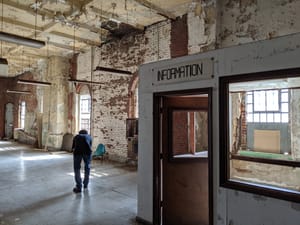I use GLAM as a category on this blog, standing duty for Galleries, Libraries, Archives and Museums. We do not have a great collective name for these institutions. Sometimes we may use memory institutions or organizations, but it can sound a little contrived.
I was interested to see Tara Brabazon writing about ‘GLAMS’ in the Times Higher. She is writing about the role of these organizations, and a particular museum in particular, in the rebranding of Wellington, New Zealand, as a cultural centre.
From this basis, a tourist and business initiative titled Absolutely Positively Wellington was able to build a tourist portfolio not only to rejuvenate but to brand the city. This was a GLAM strategy, working with the social, intellectual and economic capacity of galleries, libraries, archives and museums. [Times Higher Education – Education news, resources and university jobs for the academic world – Kiwi culture goes GLAM]
And she goes on to talk about broader relations between these several types of institution, drawing on collaborative developments in Australia and New Zealand.
There are many historical relationships between museums and archives, galleries and museums, and libraries and archives. To integrate all four institutions of memory is a rarer objective. In 2003, the Australian Society of Archives used GLAM as the hook for its annual conference, seeking strategies across the cultural sector to “glamorise culture” and assist diverse curatorial traditions while building relationships between school and university collections, along with business, labour and corporate archives. Once GLAM as a term was publicised online through this conference the usage increased, moving east to New Zealand. The internet and the challenges of digitisation were (and are) the catalyst for unifying agendas about storage, preservation, accessibility and platform migration. [Times Higher Education – Education news, resources and university jobs for the academic world – Kiwi culture goes GLAM]
She refers to the well-known work of Richard Florida on the role of the creative industries in a city or region’s prosperity and notes: “The role of GLAMs in such a narrative is underplayed, lacking policy integration with the more stylish creative industries of music, fashion and film.”
Lynne Brindley, the CEO of the British Library has recently been writing and talking about the contribution of the BL and other public ‘memory institutions’ to the UK’s creative industries, presumably trying to close that policy gap.
The Work Foundation’s 2007 report Staying Ahead notes that most members of the UK’s creative and cultural industries have in some way been helped to develop their franchise through public support and investment. This so-called ‘propitious public infrastructure’ has been accumulated over a long period and includes a rich institutional heritage of libraries, museums and galleries, the BBC, our art and design schools, our conservatoires, and theatre, opera and dance companies across the country.
The relationship between public culture and commercialised creativity is often indirect and unacknowledged. Best-selling author Stef Penney conducted research for her historical thriller The Tenderness of Wolves entirely in the British Library in London – and yet, had she not won the Costa Prize last year, we may never have learnt of the extent to which she drew on its collections. [It’s our public institutions that drive Britain’s creative surge | UK news | The Observer]
Incidentally, I have just finished Richard Florida’s latest book: Who’s your city?: how the creative economy is making where to live the most important decision of your life. I was interested in his remarks about Columbus, Ohio (where he lived briefly). He includes the Short North among what he calls ‘hipster havens’, areas with a mix of ‘city grit and posh’, and German Village is included in his list of ‘designer digs’, upscale urban neighbourhoods. And among larger regions, Columbus is in number four, between San Jose and Austin, in his list of ‘best buy’ places to live for mid-career professionals, and third, between Hartford and Austin, in his list of best places overall for gay and lesbian mid-career professionals.



